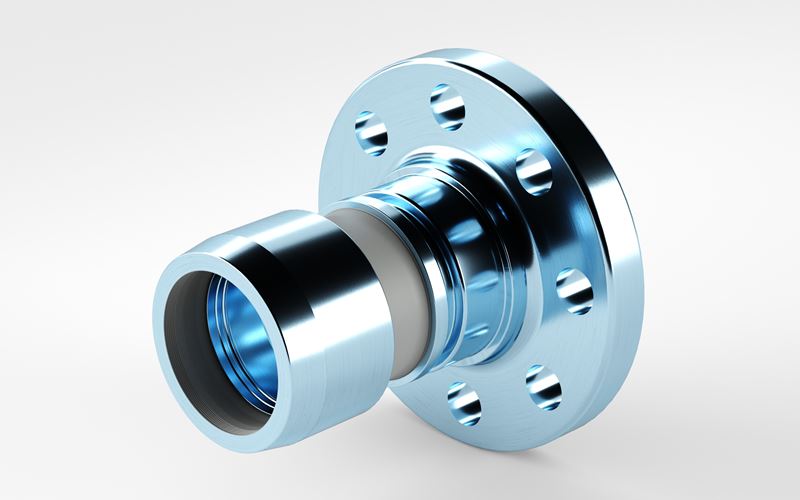What are LTCS “333” Process Fittings?
Lokring Technology released this Low Alloy Carbon Steel Solution for Sour Service applications in January 2010. Since then there has been a paradigm shift in the use of this cold-work solution being used in demanding systems offshore and in similar environments. Application list available. The Lokring “333” Process Fitting is:
- A NACE compliant fitting material (AISA/SAE 4130 (UNS G 41300) Low Alloy NACE Grade Carbon Steel) tested to NACE TMO-177 Method A.
- Qualified for use on A333 (LTCS) Piping (Charpy Impact tested)
- Designed for piping systems having a 1/8th inch or 3.2mm Corrosion Allowance.
- Can be used on sch 160 Pipe up to 2″ NPS (Currently testing for XXS Pipe up to 1″ NPS)
- Following extensive ASME Qualification Testing (Flexural Fatigue, Burst), and also Tensile, Torsion & Fire Testing (API 6FB)
Lokring has Couplings & weld-free ANSI Flanges from 1/2″ to 4″ presently available from stock. Weld-free 90 Elbows are presently in production phase. Fittings will meet the criteria of NACE MRO175 / ISO15156 and MR0103-2007 for Refineries. Fitting Material Specification meets AISI /SAE 4130 (UNS G 41300) Low Alloy NACE Grade Carbon Steel Fittings have Blue Zinc Chromate plating to ASTM B633.
Typical Class: #150, #300, #600 & #1500
Temperature Range: -46° C (-50° F) to +426° C (+800° F)
ASME B31 Qualifications Testing:
Qualified for use on A333 Gr 6, A106, API 5L & A53 Grades B
Schedule 40, 80 & 160**
Fitting Material Specification:
AISI/SAE 4130 (UNS G 41300) Low Alloy NACE Grade Carbon Steel per Lokring material specifications LMS 97-22 & LMS 09-02
Fittings have Blue Zinc Chromate plating to ASTM B633
Actual Test Description:
- Carbon Steel 4130 type material 1 1/2″ & 2″ Lokring Couplings on A333/A106 Pipe
- Internal exposure testing of the assemblies using NACE TM0 177 Solution A for a duration of 30 days
- Solution A is 5% NaCl acidified with 0.5% glacial acetic acid.
- Tests conducted at 1 atm of H2S at room temperature (76° F.) to assess Chloride Stress Corrosion Cracking (SCC) as well as Sulfide
- Stress Cracking (SSC)
- The solution & test specimens were initially deaerated with N2 followed by continuous purging of H2S for the duration
- PH was initially 2.7 and was replenished when PH reached 3.8
Key Observations & Conclusions:
- No evidence of Sulfide Stress Cracking (SSC) or Stress Corrosion Cracking (SCC) was observed in any samples
- Deemed suitable for sour service applications within the H2S partial pressure temperature limitations listed in NACE, MR0175,
- MR0103-2007 and ISO 15156
- Any temperature is allowed with a restrictive partial pressure of H2S of 15psia
Crevice Corrosion Testing
This was conducted to see the impact of corrosion within the small cavity in the Lokring fitting design with the intent to evaluate the corrosion specific to a LTCS-333 Fitting and in comparison with a Socket Weld in the same solution.
The test was based on the principles of “ASTM G78 Standard Guide for Crevice Corrosion Testing of Iron-Base and Nickle-Base Stainless Alloys on Seawater and Other Chloride-Containing Aqueous Environments” for an accelerated 30 day test.
The test solution and exposure conditions as outlined in ASTM G78 utilized Test Solution A: 5.0 wt% sodium chloride and 0.5 wt% glacial acetic acid dissolved in distilled or de-ionized water (e.g., 50.0g of NaCl and 5.0g of CH3COOH dissolveed in 945g of distilled or de-ionized water).
As a result of this testing, Lokring is now pleased to endorse Lokring LTCS-333 Fittings for applications that customers feel may result in Crevice Corrosion. We would however suggest that you work closely with your Lokring representative to ensure all parties are comfortable with the overall system conditions and parameters. This report is available on request.
When selecting Lokring fittings for use in any application, total system design must be considered to ensure a safe, trouble free performance. Material compatibility, system pressure and temperature ratings, adequate corrosion control or allowances, control of fluid velocities, fluid chemical treatment, proper installation, operation, and maintenance are the responsibilities of the system designer, owner, and operator.
** Except 3″ and 4″
